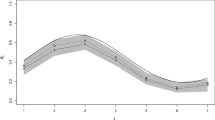Abstract
A process Y n , n ≥ 1, satisfying the stochastic recurrent equation Y n = A n Y n−1 + B n , n ≥ 1, Y 0 ≥ 0, is studied in the paper; here (A n , B n ), n ≥ 1, are independent identically distributed pairs of nonnegative random variables. The cases when the values A n have a lognormal and log-Laplace distributions are considered. The tail index κ (for a stationary distribution) and the extremal index ϑ are studied. In the lognormal case, κ is determined and some useful properties of ϑ are established. In the log-Laplace case the both characteristics are obtained in explicit form.
Similar content being viewed by others
References
W. Vervaat, “On a Stochastic Difference Equation and a Representation of Nonnegative Infinitely Divisible Random Variables,” Adv. Appl. Probab. 11, 750 (1979).
L. de Haan, S. I. Resnick, H. Rootzen, and G. C. de Vries, “Extremal Behavior of Solutions to a Stochastic Difference Equation with Applications to ARCH Processes,” Stochast. Process. and Appl. 32(1), 213 (1989).
T. J. Kozubowski and K. Podgórski, “Log-Laplace Distributions,” Int. Math. J. 3(4), 467 (2003).
P. Embrechts, C. P. Klüppelberg, and T. Mikosh, Modelling Extremal Events for Insurance and Finance (Springer, Berlin, 2003).
M. Fréchet, “Sur les Formules de Réepartition des Revenus,” Rev. Inst. Int. Statist. 7(1), 32 (1939).
T. Inoue, On Income Distribution: the Welfare Implication of the General Equilibrium Model and the Stochastic. Processes of Income Distribution Formation, PhD Thesis (Univ. Minnesota, 1978).
P. Embrechts, R. Frey, and A. J. McNeil, Quantitative Risk Management (Princeton Univ. Press, 2005).
H. Kesten, “Random Difference Equations and Renewal Theory for Products of Random Matrices,” Acta Math. 131, 207 (1973).
M. R. Leadbetter, G. Lindgren, and H. Rootzen, Extremes and Related Properties of Random Sequences and Processes (Springer, New York, 1983; Mir, Moscow, 1989).
W. Feller, An Introduction to Probability Theory and its Applications (Wiley, New York, 1971; Mir, Moscow, 1967), Vol. 2.
Author information
Authors and Affiliations
Additional information
Original Russian Text © O.C. Novitskaya and E.B. Yatsalo, 2008, published in Vestnik Moskovskogo Universiteta, Matematika. Mekhanika, 2008, Vol. 63, No. 5, pp. 6–10.
About this article
Cite this article
Novitskaya, O.C., Yatsalo, E.B. Extremal behavior of recurrent random sequences. Moscow Univ. Math. Bull. 63, 179–182 (2008). https://doi.org/10.3103/S0027132208050021
Received:
Published:
Issue Date:
DOI: https://doi.org/10.3103/S0027132208050021



